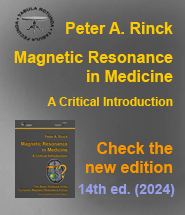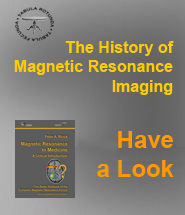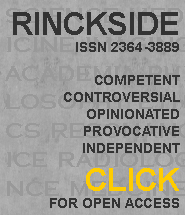Glosario
| a | b | c | d | e | f | g | h | i | j | k | l | m | n | o | p | q | r | s | t | u | v | w | x | y | z |
R
Radian: dimensionless unit of angular measure; 360° = 2π radians.
Radiofrequency (RF): wave frequency intermediate between auditory and infrared. The RF used in NMR studies is commonly in the megahertz (MHz) range. The principal effect of RF magnetic fields on the body is power deposition in the form of heating; this is a principal area of concern for safety limits.
RARE (Rapid Acquisition with Relaxation Enhancement): fast imaging method using a single excitation followed by a train of echoes.
Rapid imaging: → check Acronyms and Abbreviations.
Readout delay → TE.
Receiver: portion of the NMR apparatus that detects and amplifies RF signals picked up by the receiving coil. Includes a preamplifier, amplifier, and demodulator.
Receiver coil: coil of the RF receiver; 'picks up' the NMR signal.
Reconstruction from projections imaging: magnetic resonance imaging technique in which a set of projection profiles of the body is obtained by observing NMR signals in the presence of a suitable corresponding set of gradient magnetic fields. Images can then be reconstructed using techniques analog to those used in conventional computed tomography (x-ray CT), such as filtered back projection. It can be used for volume imaging or, with plane selection techniques, for sequential plane imaging. (→ Zeugmatography).
Refocusing: → Spin echo.
Refocusing pulse: RF pulse used to reverse the sense of precession of a signal and hence produce a spin echo.
Relaxation rates: R1 and R2; reciprocals of the relaxation times: 1/T1, 1/T2 measured in 1/s.
Relaxation times: after excitation, the spins will tend to return to their equilibrium distribution, in which there is no transverse magnetization and the longitudinal magnetization is at its maximum value and oriented in the direction of the static magnetic field. It is observed that in the absence of applied RF, the transverse magnetization decays toward zero with a characteristic time constant T2, and the longitudinal magnetization returns towards the equilibrium value M0 with a characteristic time constant T1. T1 and T2 are measured in ms.
Relaxivity: r1 and r2; enhancing effect of an MR contrast agent. Measured under standard conditions (37°C ± 2°C; at physiological pH in water or saline) expressed per paramagnetic center as:
r1,2 [s-1 × mM-1 × L].
Relaxometry: the measurement of relaxation times. This can be performed with a regular analytical magnetic resonance spectrometer in vitro or ex vivo at a defined field strength, with a magnetic resonance imager in vivo at a defined field strength, or with a field cycling magnetic resonance relaxometer in vitro or ex vivo at different fields.
Repetition time → TR.
Resistive magnet: a magnet whose magnetic field originates from current flowing through an ordinary (nonsuperconducting) conductor.
Resolution, contrast → Contrast.
Resolution, spatial: although generally referring to the ability of the imaging process to distinguish adjacent structures in the object (an important measure of image quality), the specific criterion of resolution to be used depends on the type of test used (e.g. bar pattern of contrast-detailed phantom). As the ability to separate or detect objects depends on their contrast, and the different MRI parameters of objects will affect image contrast differently for different imaging techniques, care must be taken in comparing the results of resolution phantom tests of different machines, and no single simple measure of resolution can be specified.
Resolution, time: imaging time.
Resonance: a large amplitude vibration in a mechanical or electrical system caused by a relatively small periodic stimulus with a frequency at or close to a natural frequency of the system; in an MRI machine, resonance can refer to the NMR itself or to the tuning of the RF circuitry.
Resonance frequency: frequency at which the resonance phenomenon occurs; given by the Larmor equation for NMR; determined by inductance and capacitance for RF circuits.
Retrospective gating: used in cardiac imaging. Involves collecting non-gated data while simultaneously recording the ECG signal; the latter is then used with a post- processing routine to assign the images to the correct stage in the cardiac cycle. The ECG can be replaced by additional echoes which monitor the position (navigator echoes).
Rewinder gradient → Phase rewinder gradient.
RF → Radiofrequency.
RF pulse: brief burst of RF magnetic field delivered to object by RF transmitter. For RF frequency near the Larmor frequency, it will result in rotation of the macroscopic magnetization vector in the rotating frame of reference (or a more complicated nutational motion in the stationary frame of reference). The amount of rotation will depend on the strength and duration of the RF pulse; commonly used examples are 90° (π/2) and 180° (π) pulses.
rho → Spin density.
Rotating frame of reference: a frame of reference (with corresponding coordinate systems) that is rotating about the axis of the static magnetic field B0 (with respect to a stationary frame of reference) at a frequency equal to that of the applied RF magnetic field, B1. Although B1 is a rotating vector, it appears stationary in the rotating frame, leading to simpler mathematical formulations.
Rotating frame zeugmatography: technique of magnetic resonance imaging that uses a gradient of the RF excitation field (to give a corresponding variation of the flip angle along the gradient as a means of encoding the spatial location of spins in the direction of the RF field gradient) in conjunction with stepping the duration of the RF pulse to give one-dimensional spatial encoding. It can be considered as a form of Fourier transform imaging.
Missing terms? Send us an e-mail. We'll add them ...












